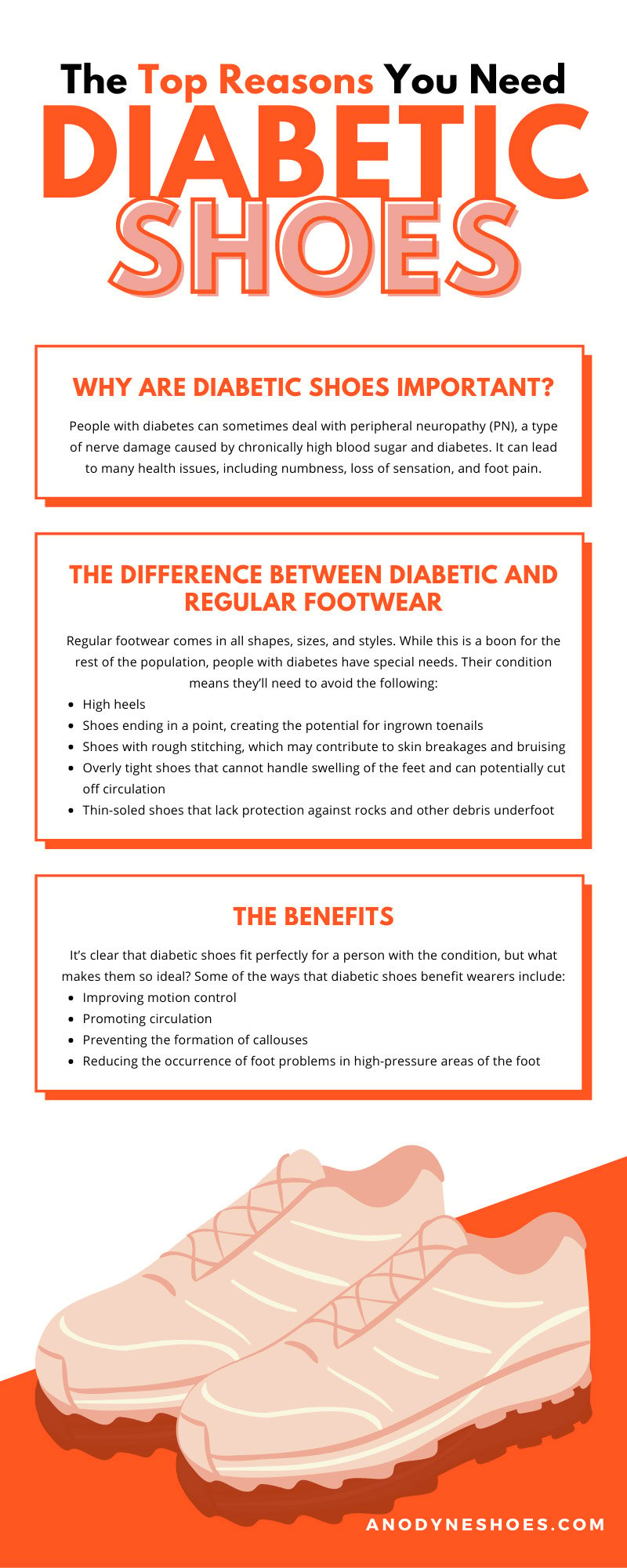.png?width=750&height=422&name=Blog%20Template%20copy-1%20(2).png)
Diabetes treatment has come a long way since the condition’s discovery. Today, people with diabetes have a much-improved life expectancy thanks to the development of pharmaceuticals and the innovation of synthetic insulin. However, ordinary people with diabetes still often have a shorter life expectancy. Without proper care and maintenance, their life expectancy can suffer.
One thing that has helped tremendously with the health and well-being of people with diabetes is specialized footwear. The footwear ultimately provides the proper support and circulation, which is key to people with diabetes. There’s a wide array of ways that diabetic shoes and sneakers contribute to a more comfortable, healthy life for those with diabetes. Read on to discover why you need diabetic shoes.
Why Are Diabetic Shoes Important?
People with diabetes can sometimes deal with peripheral neuropathy (PN), a type of nerve damage caused by chronically high blood sugar and diabetes. It can lead to many health issues, including numbness, loss of sensation, and foot pain.
Given that PN affects the feet the most, this is one of the reasons why diabetic shoes are so important. They offer breathing room for better circulation and great arch support. Most importantly, they can mitigate the formation of ulcers, calluses, and even skin breakdown.
The Difference Between Diabetic and Regular Footwear
Regular footwear comes in all shapes, sizes, and styles. While this is a boon for the rest of the population, people with diabetes have special needs. Their condition means they’ll need to avoid the following:
- High heels
- Shoes ending in a point, creating the potential for ingrown toenails
- Shoes with rough stitching, which may contribute to skin breakages and bruising
- Overly tight shoes that cannot handle swelling of the feet and can potentially cut off circulation
- Thin-soled shoes that lack protection against rocks and other debris underfoot
As you can probably guess, conventional footwear can be a guessing game for men and women who require diabetic footwear. You must assess a lot of factors to determine the right fit for you to ensure your shoes won’t cause more harm than good. This is where diabetic footwear comes in. It keeps all these factors in mind without you doing any guesswork. Women’s and men’s diabetic sneakers have many features that provide practical benefits and comfort.
Firstly, these sneakers have a protective interior made from soft material that has minimal stitching, which avoids irritation to the skin and cause scraps or bleeding. People with diabetes tend to be more susceptible to this kind of injury, and their wounds heal less quickly than most. Non-binding uppers on the shoes also ensure that there’s no pressure on the foot. A normal shoe may irritate the heel’s bunions, toes, or back.
Diabetic shoes also sport an extra-depth design to give you room to accommodate orthotics. Another key difference between standard shoes and diabetic shoes is that diabetic shoes feature a toe box that doesn’t restrict circulation. This expanded toe room gives the feet space to breathe and helps promote circulation.
The Benefits
It’s clear that diabetic shoes fit perfectly for a person with the condition, but what makes them so ideal? Some of the ways that diabetic shoes benefit wearers include:
- Improving motion control
- Promoting circulation
- Preventing the formation of callouses
- Reducing the occurrence of foot problems in high-pressure areas of the foot
Where To Find Them
Here at Anodyne, we proudly sell stylish options that provide the comfort you deserve. We’ve compiled a few pieces of must-know information for anyone with diabetes preparing to buy their shoes.
Firstly, it would help if you started finding a podiatrist. A podiatrist can recommend the right shoe for your needs. Alternatively, you can see a specialist for a fitting, such as an Certified Pedorthist (CPED) and they may even order the shoes for you.
As an even more exciting aside, Medicare or other insurance providers might cover a pair if your doctor prescribes them. Be sure that you check with your health insurance provider. Keep in mind that regulations vary depending on the type of shoes you want and the cost.
Finding the Right Fit
Once you’re ready to purchase therapeutic and refined footwear that suits your needs, the next thing to consider is the fit. Everyone’s feet are different, and the right fit can mean all the difference for those with diabetes.
Start by having your feet measured before trying on the shoes you’re considering. It’s wise to try on shoes in the afternoon, as this is when your feet tend to swell the most.
You also want to wear the same type of socks you plan on wearing each day to gauge how the shoes really feel. Socks can cause tightness, so it’s important to check this factor before you finish your fitting session.
Finally, make sure there’s plenty of room for your instep and sole of your foot and that your shoes fit snugly around the heels.
What Else Do I Need To Know?
Now that you know the top reasons you need diabetic shoes, here are a few foot care tips to support your journey.
- Check your feet every day for sores, ulcers, cuts, or calluses. Cuts can be nasty if you deal with PN, as you might not even know you have one. Therefore, manually checking is essential. Anodyne provides a mirror sticker on the inside of every shoe box which makes this task a lot more simple!
- Trim your toenails. Even if you get diabetic shoes, you’ll want to trim your toenails so that you don’t experience ingrown nails or put pressure on the nail bed.
- Smooth out any corns and calluses with a foot scrub or a pumice stone. Don’t pick at them or use any other rough surface to “sand” them down.
- Avoid using razors or sharp tools on your feet.
- Wash your feet daily with warm water to promote circulation.
- Don’t forget to be gentle when bathing your feet.
- Wear clean, dry socks. If you can find diabetic socks, all the better!
- Wear socks to bed and diabetic shoes regularly, even inside. You never know when an accident may happen, and you may step on some glass or stub your toe.
- Don’t smoke; it can restrict blood flow in your feet.
- Get foot exams often.
In short, there are a ton of reasons why as a person with diabetes, you’ll want to consider diabetic shoes. One thing is certain: improving your footwear is necessary for your health. The right shoes can safeguard you from some significant issues that people with diabetes face. Make sure you get the right shoes for you so you can step out in safety and style.



.png?width=116&name=Anodyne_circle_1_logo%20(2).png)
